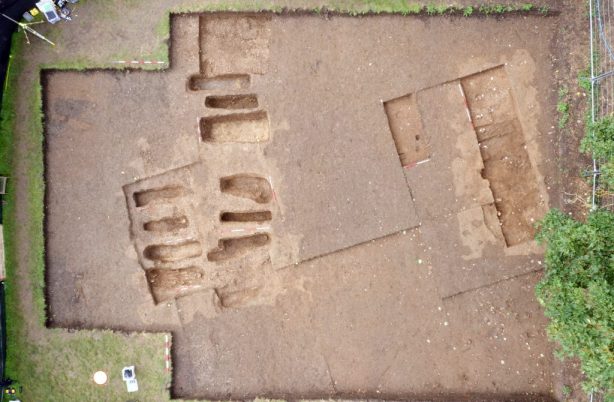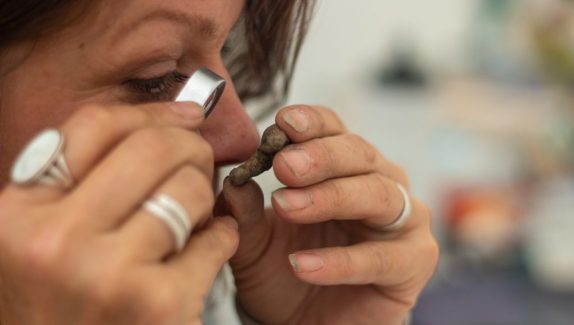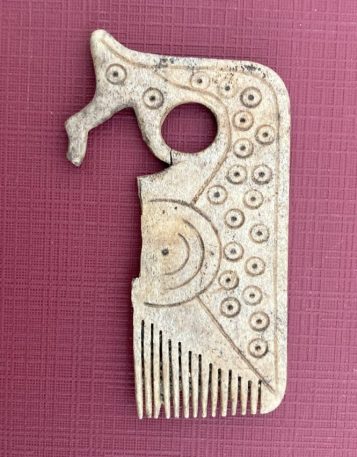‘Voices from the Past’
DNA Crowdfunding Campaign
Uncovering the lives of Cookham’s ancestors from the extraordinary remains discovered.
Help us raise money to pay for cutting-edge techniques, like isotope and ancient DNA analysis that will offer a rare insight into Anglo-Saxon life, health, diet and mobility.
You can help.
Our Target is to raise £12,000
Help us give a voice to the forgotten people of Anglo-Saxon Cookham – your support will bring their stories to life after 1,200 years of silence.
The first 20 donations of £100 or more will be invited to a unique, behind-the-scenes tour at the University of Reading to view the human remains, led by archaeological anthropologist and specialist in human palaeopathology, Professor Mary Lewis
Those who donate £25 or more will receive a specially designed print by our Artist in Residence Phyllida Shelley.
We will be able to increase the value of your donation by 25% via Gift Aid.
Voices from the Past
We are unearthing the remains of an exceptionally rare and well-preserved Anglo-Saxon royal monastery in Cookham. Its traces have remained hidden for over a thousand years.
We are excavating a cemetery which forms one element of the extensive Anglo-Saxon monastic landscape under investigation at Cookham. The site has revealed at least 80 human skeletons, buried in the 8th-9th centuries AD, after which the cemetery went out of use. These are the early people of Cookham. The skeletons have been carefully cleaned and are stored at the University of Reading. Modern scientific techniques can enable us to ask questions about their lives 1200 years ago. If we ask carefully and respectfully, these people can tell us something about themselves: we can hear their voices. We hope they’d be willing to tell us about themselves, as most people are today.
One of FCA’s main aims is to give financial support for the University’s research. We want to raise £12,000 to investigate the skeletons. We’d like your support for scientific investigations, so we can hear these voices from the past.
Unearthing Cookham’s earliest residents – using science to let 1,200-year-old Anglo-Saxon voices speak again.
A rare Anglo-Saxon monastic cemetery reveals secrets of faith, community, and daily life in early medieval England.
Why are the burials so important?
The burials in the site close to Holy Trinity Church have an important contribution to answering the project’s research questions. The excavation’s aim is a fine-grained reconstruction of the Anglo-Saxon monastic landscape. The cemetery is an essential part of this as it was found next to domestic buildings and other infrastructure belonging to the monastery. Cemeteries of Anglo-Saxon monasteries are extremely rare, well-excavated ones even more so.
Preliminary analysis indicates a high rate of pathologies relating to serious diseases and/or medical interventions. Cookham therefore provides some of the earliest evidence for the role of monasteries as healing centres in medieval England.

What can the skeletons tell us?
Every bone tells a story – illness, injury, healing, and the surprising discovery of an early English hospice.
We can construct a bioarchaeological profile of individuals to tell us about life in Cookham at the time. The first step is a general profile of the burials – their sex, age, physical evidence of lifestyle, evidence of injuries, illness and cause of death. A human bone specialist will examine and record the skeletons, without damaging them. We have already done this for the skeletons excavated in 2023, which showed that the graveyard held men, women and children, so a broader community than just nuns. There was a high proportion of pathologies – illnesses, injuries and deformities affecting the skeletons, suggesting that the monastery may have had a function as a hospice or place of healing, serving a larger population than the immediate monastic community. This would make Cookham one of the earliest hospices known in England. Examining each skeleton takes half a day, and 40 skeletons were excavated in 2024 and 2025. This work, will cost about £3,600.
Unlocking genetic time capsules – DNA reveals ancestry, family links, and diseases once hidden in Cookham’s monastery.
Ancient DNA
Cutting-edge scientific techniques can tell us much more about the lives of the people who lived and died at the monastery. The first is ancient DNA analysis This can provide vital information on the ancestry of individuals and possible family relationships. aDNA can also identify diseases and causes of death not visible on the bones, for example the impact of plagues that we hear about from early historical sources. Small samples of tooth and bone material have already been sent to the Francis Crick Institute, which is conducting a large aDNA study. so fortunately UoR will not have to pay for this work.

We are what we eat: stable isotope analysis
Traces of ancient meals remain in bone – discover how diet, famine, and farming shaped Anglo-Saxon lives.
A diet rich (or poor) in meat, dairy, fish or plants will leave a chemical signature in the body. By examining the stable isotopes in very small amounts of bone and teeth, we can find out about the quality and nature of the person’s diet, and their animal husbandry. We already know that some of the children in the cemetery suffered from anaemia, probably due to poor diet. Food supply in this period was not resilient – two bad harvest seasons would have resulted in famine and deaths. Stable isotope tests to look at diet will cost about £50 for each skeleton – £2,000 in all.
Isotope chemistry in teeth tracks movement – revealing where Cookham’s people were born, lived, and travelled long ago.
Where are you from?
The chemistry of water consumed in childhood is related to the geology of the area the child came from. The chemical signature remains in the person’s teeth, and may be different from the chemistry in the bone if the person moves to an area with different geology. So analysis of stable isotopes can show mobility during life. Isotope analysis to look at mobility and travel costs about £350 for each test. We want to raise £6,000 for this research.

How you can help
Join the journey – your support helps our researchers uncover Cookham’s lost community and let their voices be heard.
We want to build on the huge interest in the dig shown by local people and businesses. We are sure that your interest and generosity will enable us all to listen to these voices from the past.
We thank Holy Trinity Church for their goodwill and interest in the dig.


